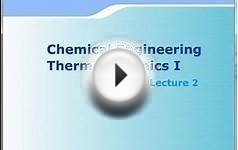The second edition is now available. This site will no longer be updated.
Introductory Chemical Engineering Thermodynamics is a textbook designed primarily for undergraduate chemical engineering students. The text provides coverage of molecular concepts, energy and entropy balances, equations of state for thermodynamic property calculations, and activity models. Programs are provided for HP and TI calculators, spreadsheets, and FORTRAN compilers (All PC platform). Computer programs are utilized in example problems. Practice problems are provided at the end of almost every chapter with the answers. Some of the pages on this website utilize the free to preserve formatting and graphics.
Please note that the text is under development for a 2nd edition. Some major changes include: 1) more applications of energy balances; 2) covering energy balances for reactive systems before process thermodynamics; 3) improved coverage of Raoult's law and Modified Raoult's Law to permit more accessible instruction on applications; 4) VLE by EOS now covered after modified Raoult's law; 5) Incorporation of MATLAB; 6)Biological and electrolyte topics including osmotic pressure and tranformed Gibbs energies, and redox reactions.









 Physical chemistry is the study of macroscopic, atomic, subatomic, and particulate phenomena in chemical systems in terms of laws and concepts of physics. It applies the principles, practices and concepts of physics such as motion, energy, force, time...
Physical chemistry is the study of macroscopic, atomic, subatomic, and particulate phenomena in chemical systems in terms of laws and concepts of physics. It applies the principles, practices and concepts of physics such as motion, energy, force, time...